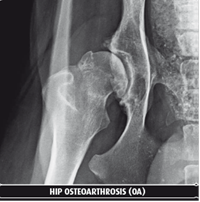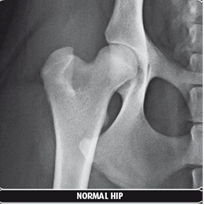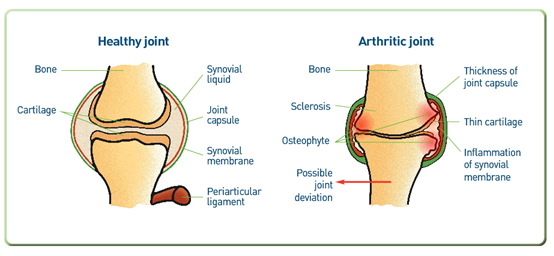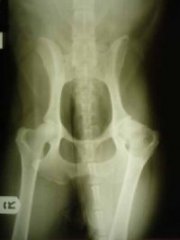Also known as Degenerative Joint Disease (DJD) occurs as a result of wear and tear on the joints over time. Osteoarthritis is most common in older animals due to the progression of normal wear and tear over the years.
In some cases osteoarthritis will be present at an earlier age due to specific joint diseases such as hip dysplasia or cruciate disease. These cause instability in the affected joint and therefore there is accelerated wear and tear. Rheumatoid arthritis which is common in humans is less common in dogs.


The most common symptom of osteoarthritis is lameness. Often this will be intermittent or wax and wane. Often it will be worse when your pet first gets up. Some animals don’t have an obvious limp but may be generally stiff. They may be slow getting up after lying down, or may not be as enthusiastic about their walks as usual. Often these signs of joint pain are mistaken for slowing down with age but osteoarthritis causes pain in and around your pet's joint.
Osteoarthritis in cats
Because cats are relatively small and agile, and because arthritic changes in joints often affect both sides-for example both left and right hindlimbs-it can be hard to spot signs of obvious lameness. Arthritis may occur wherever there is a joint. It may affect the forelimbs, hindlimbs or spine, or a combination of these areas. Cats generally don't limp even when they are in pain as they are especially good at hiding signs of pain. Instead, cats affected by arthritis are more likely to show subtle changes in their lifestyle or behaviour. The signs may manifest as sleeping more, grumpiness or lack of grooming. Learning to recognise these signs in your cat will allow you to monitor their condition and assess their response to any changes you make such as giving medication.
Osteoarthritis is a progressive and incurable condition but there are treatment options to help manage it and relieve the symptoms.
Surgery
If your pet’s osteoarthritis is secondary to a specific problem e.g. cruciate ligament disease or patellar luxation, surgery may be an option to stabilise the joint and reduce the progression of the osteoarthritis. In the most severe cases joint replacements may be an option but these are usually a last resort.
 Medication
Medication
The most common class of drug used is non-steroidal anti-inflammatories (NSAIDs) which provide both pain relief and reduce inflammation. There are various products available in different formulations. Your vet will help you decide which one is most appropriate for your pet. Side effects to the drugs we use are uncommon but all NSAIDs can potentially cause tummy upsets. Sometimes other painkillers are used instead of or in conjunction with NSAIDs. Cartrophen is an injection given to reduce pain and inflammation in the joints. It is usually administered as a course of 4 injections given 1 week apart. Whist some dogs respond very well the degree and duration of improvement can be variable.
Weight control
This is a vitally important part of managing osteoarthritis. Excess weight puts excess strain on the joints and greatly accelerates the wear and tear process. If your pet is overweight then we will discuss a suitable diet plan with you. Sometimes weight loss results in such an improvement in symptoms that we no longer need to use painkillers. Our veterinary nurses at Cinque Ports Vets run Weight Management Clubs to help you and your pet manage their weight loss.
Exercise
It is vital to keep an arthritic pet moving to maintain muscle mass and joint mobility. Exercise moderation is important, particularly for dogs. Gentle regular exercise is preferable to occasional long or strenuous runs. Although your dog may enjoy the exercise they will tend to be stiff and sore afterwards. Try to find what level of exercise your pet can cope with that doesn’t aggravate the symptoms and do not exceed that. Aim for several shorter walks each day. If your pet has a ‘flare-up’ of osteoarthritis symptoms reducing the exercise for a few days can help the inflammation subside.
Hydrotherapy as a non-weight bearing exercise can help to improve muscle tone, improve the range of motion of the joints without putting stress on the joints and assist with weight loss. It is important to ensure that hydrotherapy is performed at a centre which is registered with the Canine Hydrotherapy Association. This means that they will regularly have been inspected and audited to receive their certification and will also liaise with your veterinary practice in regard to progress and treatment. Hydrotherapy is performed in a controlled environment using warm water and specialised equipment. It is not the same as taking your pet swimming in cold water which causes constriction of their blood vessels near the skin and muscles, restricting their blood flow and making their muscles less efficient. We can refer your pet to suitable centres for hydrotherapy.
Nutraceuticals
These are dietary supplements which can help modify a disease process. There is some evidence in humans that they slow the progression of osteoarthritis over time. Glucosamine and chondroitin sulphate are the most commonly used. These products are very safe with minimal side effects but as they are not considered drugs the products on sale are not tightly regulated. It is important to use a reputable brand of product as the quality and concentration of the ingredients varies widely and is very often reflected in the price. Your veterinary surgeon will be happy to help you decide which product will be best suited to your pet.
Complementary treatments
Some pets appear to respond well to treatments such as laser therapy and acupuncture. We are able to offer both these services at Cinque Ports Vets.
Laser Therapy
Our Class IV deep tissue laser therapy machine is designed to offer a surgery-free, drug- free, non invasive treatment to:
- reduce pain
- reduce inflammation
- speed healing
The laser uses a beam of laser light to deeply penetrate tissue without damaging it. Laser energy induces a biological response in the cells called 'photo-bio-modulation', which increases circulation, drawing water, oxygen and nutrients to damaged cells. This leads to reduced pain, reduced inflammation and increased healing speed. Laser therapy has been scientifically proven to be successful in treating post surgical pain and many acute and chronic conditions as listed below:
| Acute Conditions | Chronic Conditions |
| Post surgical healing and pain relief | Degenerative Joint Disease |
| Wounds | Inflammatory Bowel Disease |
| Allergies | Periodontal Disease |
| Infections | Lick Granulomas |
| Cuts/Bites | Geriatric Care |
| Inflammations | Hip Dysplasia |
| Tooth extraction pain relief | Tendonitis |
| Sprains,strains and fractures | Otitis and much more! |
For more information and FAQ's please click here Commonly Asked Questions
Our Pet Health Counsellors offer free Mobility Clubs to help assist you and your pet cope with the problems osteoarthritis and aging can cause. Why not answer our Canine or Feline Mobility Questionnaire and see if your pet could benefit.
Click on the videos below to watch more about arthritis in dogs and how to help spot the signs of arthritis in your cat.
Please click on the videos below to see two dogs with naturally occurring osteoarthritis, who were trialled on Royal Canin Mobility diets. The before videos are taken on Day 1 and the after videos are taken on Day 50.
Useful links:
www.freedomtomove.co.uk
www.metacam.co.uk
www.spotcatpain.co.ukwww.nutravet.co.uk




